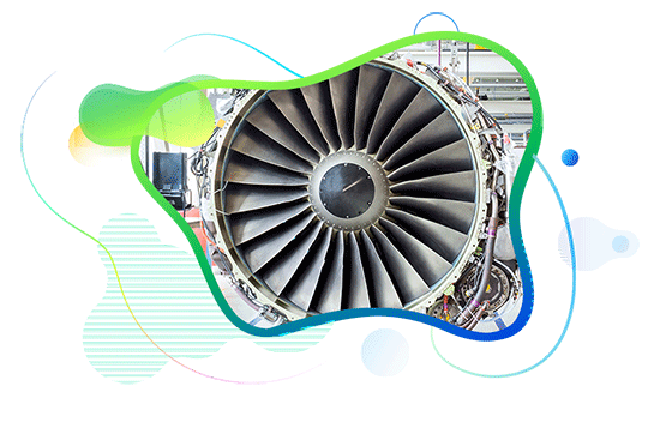
It is a well-known fact that Aviation, as an industry relies heavily on the availability of a constant stream of data that can empower intelligent decision making. Naturally, any technology that aids this, like Big data, RFIDs, SCADA etc is almost always welcomed immediately.
Of all the technology platforms tipped to revolutionize data generation and availability in the past few years, the Internet of Things (IoT) is possibly the most hyped and deemed; the most promising. Defined as a technology in which data from multiple equipment and devices can be transferred over a network without requiring human-to-human or human-to-computer interaction, IoT has developed from futuristic sci-fi concept to a real-life technology owing to the rise in connected devices.
The central factor governing such a data flow is the availability of sensors, essentially embedding them into every conceivable systems in an aircraft and harnessing the massive amounts of data that they generate.
Sensors have always been available on aircraft; especially engines, with OEMs like General Electric and Pratt & Whitney tracking everything from fuel consumption to reliability measurements. However, what was earlier a standalone tracking system with data being stored and downloaded on the ground for analysis after the event, is being tracked, and actioned upon, in real time with the rise of lower cost computing solutions. This aids instant decision making, while also enhancing the power of prediction, thus having a big impact on the commercial aviation sector.
The implications of such technology are profound.
The information generated inflight as such can be used to optimize jet fuel consumption, improve engine efficiency and, in the long term, drastically reduce maintenance costs. Such data, could be used to effect minor changes to flight plans and air speed to reduce flight times, fuel consumption and possibly avoiding errors.
Given the right sensors and software, IoT technology could detect an anomaly in a jet engine or its associated hardware, software or systems. This could, in theory, prevent accidents. Systems will also be able to notify suppliers of parts that need to be replaced and provide alerts to maintenance personnel.
This entire concept of IoT has evolved to the creation of new value propositions and potential revenue streams from new business models:
- OEMs have started focusing on gearing up their Service programs aimed at helping airlines find efficiencies in reducing fuel costs using real time data analysis.
- New aircraft models like Dreamliners for instance come pre-designed with IP enabled avionics systems that permit real time data to be transmitted to the cockpit and to operations centers on the ground on flying conditions and discrepancies observed during the flight.
- Data generated from OEMs are also being used to do a proactive assessment of aircraft & component operations to generate tailored maintenance programs, thus generating value for customers.
- IoT is being used to analyze passenger traffic patterns at airports to estimate downtimes before aircraft departures.
- Airlines have initiated plans to use facial recognition software to improve the passenger experience by using data transfer between machines to reduce lost luggage, flight delays and even cut down queues at the security line.
- Real time location data of aircraft that impact a host of actions ranging from Advertising bill boards to flight information dashboards to deciding on optimized routes
With so much potential being touted, it is natural that OEMs like GE have developed new engine types having as many as 5000+ data sensors and generating close to $1 billion in incremental income through performance improvements alone.
However, to attain the complete benefits there are still a few challenges that have to be overcome.
To begin with, for the various connected devices to communicate in harmonious manner, a common coding or language has to be enabled. This may well be the biggest roadblock for IoT, as until all the devices are compatible with each other, the very purpose of implementing IoT may not materialize.
The basic framework of IoT is its dependency on sensors to generate the data. These devices have to be inexpensive, compatible, error and maintenance free. Unless these sensors are fully operational and deliver operational data, their usage is limited.
Also, the true value of the IoT technology can only be realized if the context and time-series data is available. Otherwise it is very difficult to process this data and derive a forecast model for predictive analysis and business intelligence.
Thus at its core, the entire technology is a highly interconnected network. This calls for a seamless integration between network providers, IoT platform providers and IT services firms, who all need to collaborate effectively to deliver a successful IoT solution.
This is where, ERP systems like Ramco Aviation software effectively gear up to support the aviation sector to shift from stand-alone legacy systems and move to a more integrated environment that supports cloud services and automation frameworks.
With a robust and comprehensive M&E and MRO solution at its core, Ramco has been in the forefront, when it comes to the latest Predictive Maintenance technologies for Aircraft health Monitoring.
The possibilities are endless and exciting.
From automatically creating work packages that consider, real time spare parts, hangar space and skill availability, to interfacing with advanced diagnostic systems that use Unmanned Airborne Vehicles (drones) to stream data, for predictive analysis, Ramco has the capability to leverage data, analytics and technology to not only reduce the time for Maintenance, but also to recommend the optimal rescheduling of task sequences for Predictive Maintenance.
With OEMs like General Electric (GE) being the early adopters, it is only a matter of time before others follow suit and IoT becomes a mainstream technology.
Frequently Asked Questions (FAQs)
Enterprise asset management (EAM) involves the management of mission critical assets of an organization throughout each asset's lifecycle. EAM is used to plan, optimize, execute, and track the needed maintenance activities with the associated priorities, skills, materials, tools, and information. The aim is to optimize the quality and utilization of assets throughout their lifecycle, increase productive uptime and reduce operational costs.
Enterprise asset management (EAM) involves the management of the maintenance of physical assets of an organization throughout each asset's lifecycle. EAM is used to plan, optimize, execute, and track the needed maintenance activities with the associated priorities, skills, materials, tools, and information.
The software helps in effective maintenance of assets through preventive, predictive, shutdown and breakdown maintenance strategies. The system also helps enterprises mitigate equipment risks by enhanced safety standards. The streamlined operations and improved asset performance helps organizations increase their investment effectiveness.
EAM is important because it helps organizations track, assess, manage and optimize asset quality and reliability. Asset intensive Organizations have hundreds, thousands, even millions of assets which needs to be maintained to maximize / optimize life of these assets to increase the return on investment.
The key features of effective EAM are:
- Work management.
- Maintenance Strategies (Preventive/ Predictive / Breakdown / Shutdown).
- Planning and scheduling.
- Supply chain management.
- Health and safety.
- Mobility.
- Analytics.
- Improved Asset Health at reduced cost through data driven maintenance Programs
- Complete visibilityon entire maintenance data across Equipment, across Models, across Branches to aid in analysis & decision making such as to Repair or Replace the Equipment
- Insightful analysis of Inspection Data to improve customer satisfaction
- Effective maintenance management enhanced by predictive maintenance and inbuilt analytics
- Increased reliability and safety, keeps complete track of all the inspections & calibration schedules
- Mobile Application enables users to execute work while “in the field” leading to minimized non-productive time and increased productivity and reduces duplication of work and human errors in recording information.
- Quick turnaround time through Actionable Notification & Alerts for every process in real time and accessible anytime and anywhere.
- Improved Regulatory Part of asset management involves the implementation of better O&M practices, which can significantly improve compliance.
Asset Intensive companies under the following Industries :
- Ports
- Cement and Mining
- Utilities
- Fleet Maintenance
- Equipment Rental
- Other Manufacturing
- Real Estate & Infrastructure
- Power Generation
Contact us for a meeting and schedule a demo
This differs on case to case basis, based on the type of installation and unique industry specific requirements. Contact us for a meeting and schedule a demo.
This differs on case to case basis, based on the type of installation and unique industry specific requirements. Contact us for a meeting and schedule a demo.
Stay Connected, follow us on LinkedIn / Twitter to know more about EAM Software latest trends.


